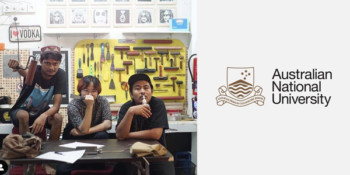Joanne Leong was a participant in the 2019 Creative Arts and Design Professional Practicum from the Australian National University. Joanne is studying a Double Degree in Arts and Visual Art. Joanne received a $3,000 New Colombo Plan Mobility Grant to support her participation in this program.
Q: Why did you decide to undertake ACICIS’ Creative Arts & Design Professional Practicum?
I’m interested in participatory, collective and socially oriented art practices, which have a strong history in Indonesian art, from pre-modern traditional sanggar to contemporary activist art collectives today. I wanted to learn more about ways of practicing art and other creative endeavours that involved other people’s ideas more directly and meaningfully, so that the work isn’t just about my opinion, but also acknowledges and facilitates the sharing of other people’s thoughts and experiences. I’m also interested in interchanges and the shared building of artistic knowledge between Australian and Asian art communities.
Q: Did you receive a New Colombo Plan Mobility Grant? If so, how did this contribute to your experience in Indonesia?
Yes, what I received from New Colombo Plan Mobility Grant covered my housing and allowed me to afford experimenting with materials and techniques that I may not have otherwise been able to explore.
Q: How will the Creative Arts & Design Professional Practicum benefit or influence your future career?
During the practicum, I made lots of friends and mentors who taught me a lot about different ways of practicing art, and different ways of building relationships and communities. Hopefully I’ll collaborate with them someday in the future!
Q: Which organisation did you intern with? What were your roles and responsibilities?
I interned with Grafis Huru Hara, a printmaking collective and studio based in Gudskul, an ‘ecosystem’ of creative collectives, groups and friends. In my time with Grafis Huru Hara, I learnt experimental printmaking techniques, like Kitchen-litho, a type of planographic printing technique that uses aluminium foil instead of limestone, and Coca-Cola instead of nitric acid. I planned a solo exhibition and created an installation, several prints and an audio-visual of interactive work. I also organised and taught a printmaking/zine workshop. More generally, I also explored the activities and projects at Gudskul, like their class on collective creative practice that’s been running for about a year now.
Q: How is the work culture of your host organisation different to work experience you have had in Australia?
Based on friendship and conviviality, and deceptively casual to one accustomed to Australian arts bureaucracy. Projects and ideas emerged from meandering and relaxed conversations, from the building of relationships between individuals. Also, there is a stereotype that life is slow in South-East Asia. In Australia, it usually takes me at the very least a month to get a collaborative event up and running, and if I’d like to exhibit my work, I’ll usually apply anywhere from two months to a year in advance. During the practicum, Grafis Huru Hara asked me to present a solo exhibition in less than a month, and a friend I made at Gudskul invited me to join a noise/visual collaborative event the night before it happened. There was a great sense of energetic possibility and inclusiveness that I missed greatly when I returned to Australia.
Q: Would you like to return to work in Indonesia again in future?
Yes, I’d like to continue working with and learning from the friends I made there. I would’ve liked to have spent more time working through different printmaking techniques at Grafis Huru Hara. I’d also like to learn more about collective art practices and navigating an international and still-Western-dominated art world from an Asia-based perspective. I also didn’t finish reading all the books I wanted to read at the library at Gudskul!
Q: What do you like to do in your spare time in Indonesia?
I visited a lot of art galleries and openings, and I read lots of art books. I tried different types of Indonesian homebrewed drinks. I also went to several experimental noise concerts and events, like Jogja Noise Bombing, an experimental sound festival based in Jakarta. Some of the Indonesian musicians I was listening a lot to in my time were Senyawa, Sarana, Logic Lost and Gabber Modus Operandi.
Q: Favourite place to eat and favourite Indonesian food?
Shout-out to IPOKICON, a coffee store in Gudskul that plays host to a number of music and creative events. I enjoyed eating at Padang restaurants; they serve a wide variety of little plates of food that you can pick and choose, from pickled vegetables to fried chicken to sambal to cow brain.
Q: Favourite Indonesian word/phrase?
Nongkrong – to hang out and talk, sometimes smoke. Time that isn’t explicitly productive, time to build relationships with friends, time to explore ideas without worrying about outcomes or practicalities. I find myself forgetting the value of time like this and find myself lacking when I don’t make space for nongkrong.
Q. What places in Indonesia have you visited during your practicum so far?
I stayed mostly in Jakarta, but visited Yogyakarta for an experimental noise festival. In Jakarta, my key stomping grounds were Grafis Huru Hara and Gudskul, where I was based for my internship, and Artland, an impressively stocked art store chain. In Yogyakarta, I spent most of my free time visiting art institutions like Cemeti and the Indonesian Visual Arts Archive.


